By Leen Randell
Updated: Jul 04, 2024
10 Best Herbal Decoctions For Gum Swelling

Herbal decoctions for gum swelling are natural remedies made by steeping herbs in hot water to create a medicinal liquid that helps reduce inflammation and alleviate discomfort associated with swollen gums.
These decoctions work by releasing active compounds that combat bacterial infections, ease pain, and promote healing. Examples of effective herbal decoctions include those made from chamomile, calendula, and peppermint, which have been used for centuries to soothe gum swelling and improve oral health.
By using these decoctions, individuals can enjoy relief from discomfort and reduce the risk of more serious complications, ultimately improving their overall well-being.
The following article describes in detail the most important decoctions for gum swelling, including medicinal properties, parts of herbs to use, and recipes for preparations.
- 1. Glycyrrhiza glabra
- 2. Calendula officinalis
- 3. Taraxacum officinale
- 4. Melissa officinalis
- 5. Echinacea angustifolia
- 6. Hypericum perforatum
- 7. Myrrhis odorata
- 8. Symphytum officinale
- 9. Achillea millefolium
- 10. Matricaria chamomilla
- What is the best combination of herbal decoctions to use for gum swelling?
- What ailments similar to gum swelling are treated with herbal decoctions?
1. Glycyrrhiza glabra
Licorice decoctions helps with gum swelling because of its anti-inflammatory properties, which help to reduce redness and puffiness.
The extract from the licorice root contains compounds like glycyrrhizin, which inhibits the production of prostaglandins, a hormone-like substance that causes inflammation in the mouth. This natural remedy also has antiseptic properties, which help to combat bacteria and viruses that can contribute to gum swelling.
As a result, herbal licorice decoctions can provide relief from swollen gums and promote overall oral health.
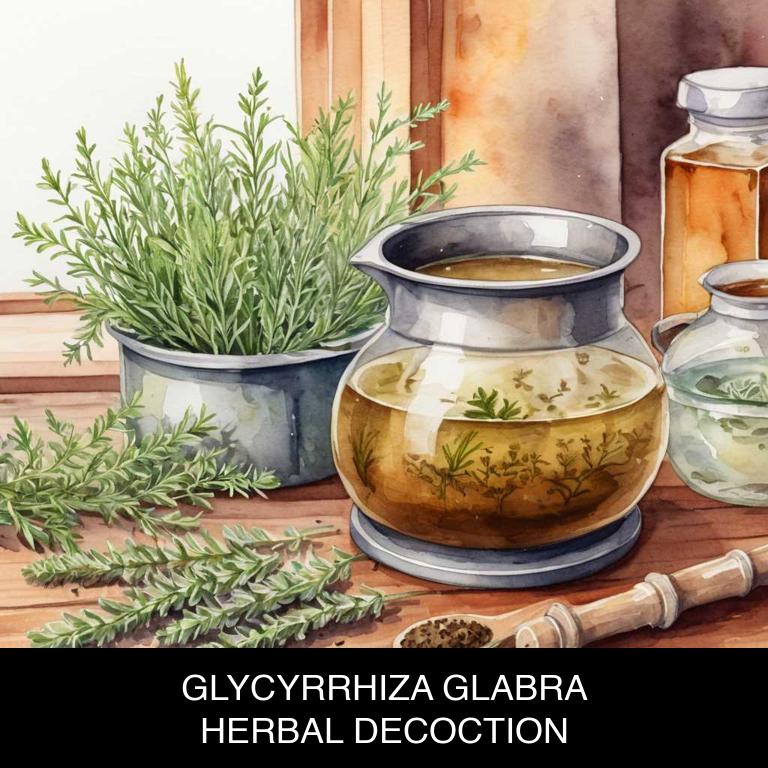
Medicinal Constituents
The list below shows the primary medicinal constituents in Glycyrrhiza glabra decoctions that help with gum swelling.
- Glycyrrhizin: Acts as an anti-inflammatory agent by inhibiting the production of pro-inflammatory enzymes and cytokines, thus reducing gum swelling.
- Licopyrone a: Exhibits anti-inflammatory and antioxidant properties, which help in reducing inflammation and oxidative stress in gum tissues, thereby alleviating swelling.
- Glucuronic acid: Possesses anti-inflammatory and analgesic properties, which help in reducing gum inflammation and pain, thus providing relief from swelling.
Parts Used
The list below shows the primary parts of licorice used to make decoctions for gum swelling.
- Roots: The roots are the most commonly used part due to their high glycyrrhizin content, which is responsible for the anti-inflammatory properties that help reduce gum swelling.
- Leaves: The leaves contain smaller amounts of glycyrrhizin but are still used in decoctions to treat gum swelling due to their overall medicinal properties.
- Barks: The barks are occasionally used in decoctions to treat gum swelling due to their anti-inflammatory and antibacterial properties, although they contain less glycyrrhizin than the roots.
Quick Recipe
The following recipe gives a procedure to make a basic licorice for gum swelling.
- Harvest 30 to 60 grams of dried roots of glycyrrhiza glabra for decoction.
- Chop the roots into smaller pieces to increase the surface area for infusion.
- Combine the chopped roots with 1 liter of water in a saucepan.
- Boil the mixture for 10 to 15 minutes to release the active compounds.
- Strain the liquid and discard the solids to obtain the final decoction.
2. Calendula officinalis
Pot marigold decoctions helps with gum swelling because of its anti-inflammatory properties, which help to reduce redness and discomfort in the gums.
The flavonoids present in pot marigold, such as luteolin and apigenin, have been shown to inhibit the production of pro-inflammatory enzymes, thereby reducing inflammation and promoting healing.
Additionally, pot marigold's antioxidant properties help to protect the gums from damage caused by free radicals, further contributing to its effectiveness in soothing gum swelling.
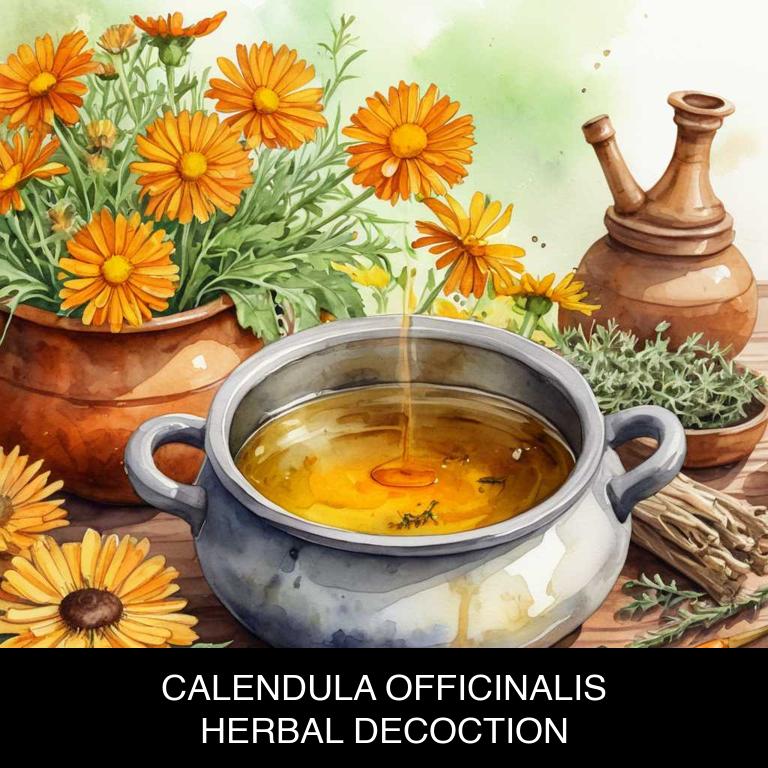
Medicinal Constituents
The list below shows the primary medicinal constituents in Calendula officinalis decoctions that help with gum swelling.
- Quercetin: This flavonoid helps with gum swelling by reducing inflammation and inhibiting the production of pro-inflammatory enzymes.
- Saponins: These glycosides help with gum swelling by reducing inflammation and inhibiting bacterial growth, which can contribute to gum inflammation.
- Beta-sitosterol: This phytosterol helps with gum swelling by reducing inflammation and inhibiting the production of pro-inflammatory eicosanoids.
Parts Used
The list below shows the primary parts of pot marigold used to make decoctions for gum swelling.
- Flowers: They are used due to their anti-inflammatory and antimicrobial properties, which can help reduce swelling and prevent infection in the gums.
- Leaves: They are used because of their ability to reduce inflammation and promote healing, which can aid in treating gum swelling and promoting healthy gum tissue.
- Roots: They are used due to their potential to reduce pain and inflammation, which can help alleviate discomfort and promote healing in the gums.
Quick Recipe
The following recipe gives a procedure to make a basic pot marigold for gum swelling.
- Harvest 10-20 fresh calendula officinalis flowers at dawn when dew is present to ensure optimal potency.
- Rinse the harvested flowers with cool water to remove dirt and debris then gently pat dry.
- Combine the dried flowers with 1 cup of boiling water in a heat-resistant glass container to create a decoction.
- Steep the mixture for 10-15 minutes then strain the liquid through a cheesecloth or fine-mesh sieve into a clean container.
- Store the decoction in an airtight glass container in the refrigerator for up to 3 days before consumption.
3. Taraxacum officinale
Dandelion decoctions helps with gum swelling because of its anti-inflammatory properties, which effectively reduce redness and pain in the gums.
The antioxidants present in dandelion root and leaves also help to combat oxidative stress, a major contributor to gum inflammation. Additionally, dandelion's antimicrobial properties work to eliminate bacterial infections that can cause swollen gums, allowing for a healthy balance of oral flora.
This natural remedy provides a soothing and effective solution for alleviating gum swelling and promoting overall oral health.
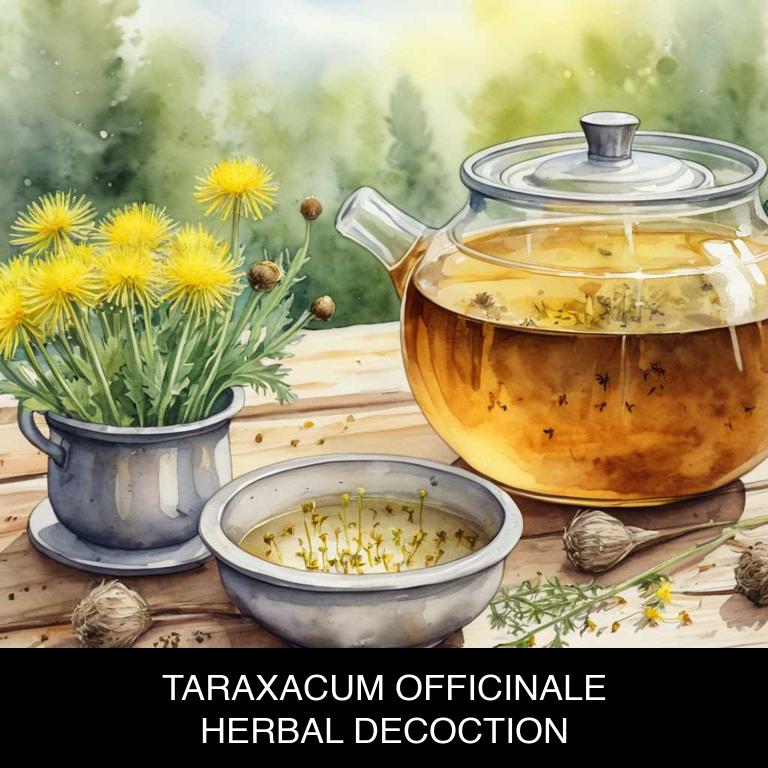
Medicinal Constituents
The list below shows the primary medicinal constituents in Taraxacum officinale decoctions that help with gum swelling.
- Taraxasterol: A triterpenoid saponin that exhibits anti-inflammatory properties, helping to reduce gum swelling by inhibiting the production of pro-inflammatory enzymes.
- Taraxasterol acetate: A triterpene saponin that has been shown to possess anti-inflammatory and analgesic effects, contributing to the reduction of gum swelling and associated pain.
- Flavonoids: Polyphenolic compounds that exhibit anti-inflammatory and antioxidant properties, helping to reduce gum swelling by scavenging free radicals and inhibiting the production of pro-inflammatory mediators.
Parts Used
The list below shows the primary parts of dandelion used to make decoctions for gum swelling.
- Roots: The roots of Taraxacum officinale are used because they contain taraxasterol, which has anti-inflammatory properties that can help reduce swelling.
- Leaves: The leaves of Taraxacum officinale are used because they contain taraxanthin, a triterpene ester with anti-inflammatory and antiseptic properties.
- Flowers: The flowers of Taraxacum officinale are used because they contain taraxasterol and taraxanthin, which have anti-inflammatory properties that can help reduce swelling.
Quick Recipe
The following recipe gives a procedure to make a basic dandelion for gum swelling.
- Harvest 20-30 fresh taraxacum officinale leaves and flowers in the morning for optimal potency and flavor.
- Chop the taraxacum officinale leaves and flowers into small pieces to release their essential oils and flavor compounds.
- Combine 2 tablespoons of chopped taraxacum officinale with 1 cup of boiling water in a heat-resistant glass container.
- Steep the taraxacum officinale mixture for 5-7 minutes to allow the flavors and nutrients to infuse into the water.
- Strain the taraxacum officinale decoction through a cheesecloth or fine mesh into a clean container for consumption.
4. Melissa officinalis
Lemon balm decoctions helps with gum swelling because its natural anti-inflammatory properties soothe and calm irritated gum tissues.
The decoction's gentle astringent action helps to reduce excess saliva production, which can contribute to swelling. Additionally, lemon balm's antimicrobial properties help combat bacterial growth that can cause inflammation and discomfort.
By reducing inflammation and promoting healthy gums, herbal lemon balm decoctions offer a natural solution for alleviating gum swelling and promoting overall oral health.
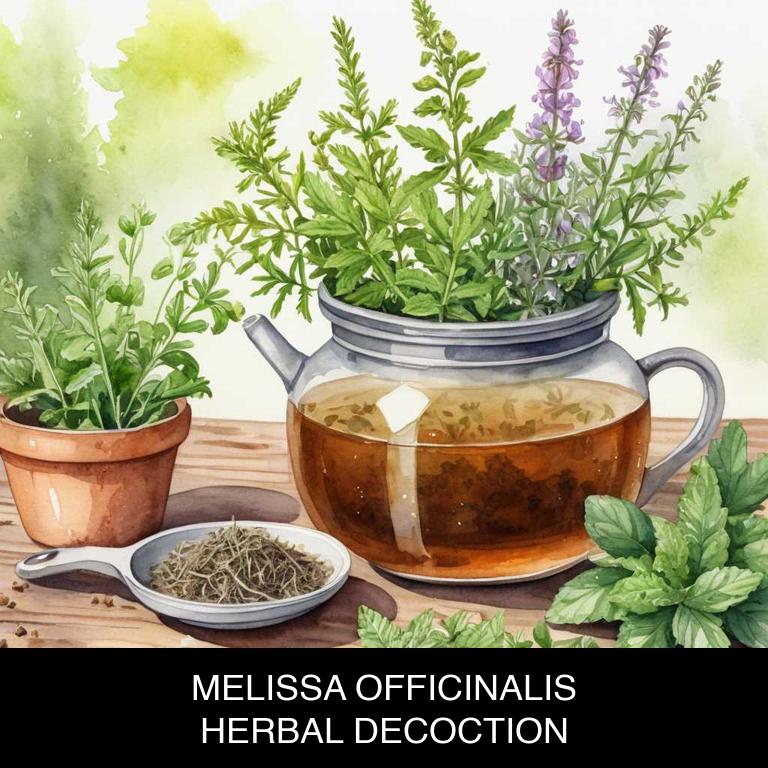
Medicinal Constituents
The list below shows the primary medicinal constituents in Melissa officinalis decoctions that help with gum swelling.
- Rosmarinic acid: A polyphenolic compound that exhibits anti-inflammatory properties, which can help reduce swelling in the gums by inhibiting the production of pro-inflammatory enzymes.
- Ursolic acid: A triterpenoid that has potent anti-inflammatory and antimicrobial effects, which can help alleviate gum swelling by reducing inflammation and inhibiting the growth of bacteria that contribute to gum disease.
- Linalool: A terpene that possesses anti-inflammatory and antioxidant properties, which can help mitigate gum swelling by reducing inflammation, preventing oxidative stress, and promoting healing in the affected area.
Parts Used
The list below shows the primary parts of lemon balm used to make decoctions for gum swelling.
- Leaves: The leaves of Melissa officinalis are commonly used to make decoctions for gum swelling due to their anti-inflammatory properties.
- Roots: The roots of Melissa officinalis are used to make decoctions for gum swelling as they contain compounds with antimicrobial and anti-inflammatory effects.
- Stems: The stems of Melissa officinalis are also used to make decoctions for gum swelling due to their ability to reduce inflammation and alleviate pain.
Quick Recipe
The following recipe gives a procedure to make a basic lemon balm for gum swelling.
- Harvest 20-30 grams of melissa officinalis leaves and flowers at peak bloom for optimal potency and flavor.
- Dry the harvested melissa officinalis in a warm place for 24-48 hours or until completely dry and brittle.
- Combine 5-10 grams of dried melissa officinalis with 1 liter of boiling water for a decoction.
- Steep the mixture for 5-10 minutes and then strain it through a cheesecloth or fine-mesh sieve.
- Store the decoction in the refrigerator for up to 3 days and consume 20-30 milliliters as needed.
5. Echinacea angustifolia
Kansas coneflower decoctions helps with gum swelling because of its anti-inflammatory properties.
The plant's active compounds, such as triterpenoids and phenolic acids, have been shown to reduce inflammation and alleviate pain associated with gum disease. The decoction's antibacterial properties also help combat the underlying bacterial infections that can cause gum swelling.
By reducing inflammation and combating infection, Kansas coneflower decoctions provide a natural and effective way to soothe and heal swollen gums.
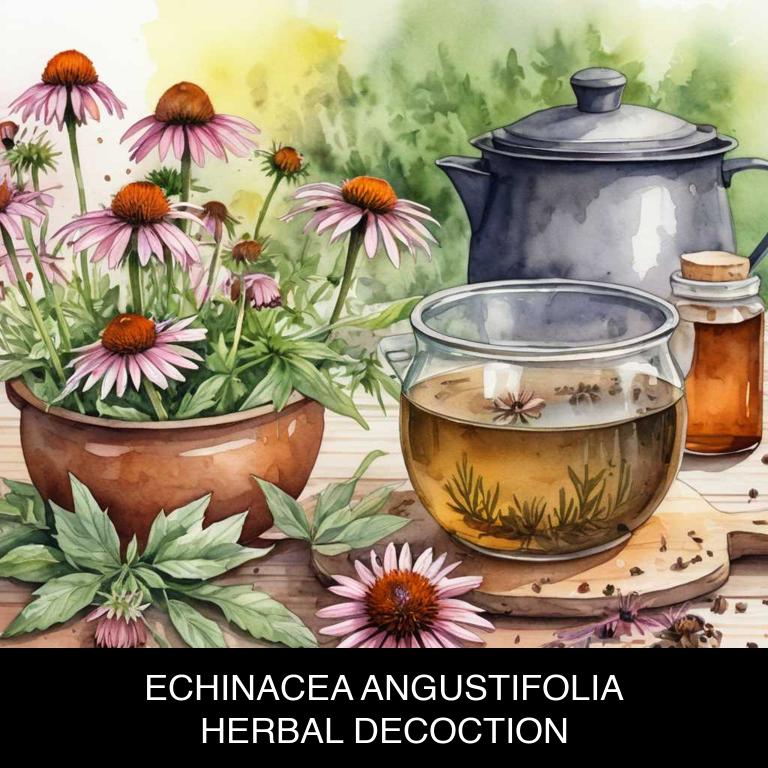
Medicinal Constituents
The list below shows the primary medicinal constituents in Echinacea angustifolia decoctions that help with gum swelling.
- Iridoid glycosides: These compounds have anti-inflammatory properties, which help to reduce swelling and alleviate pain in the gums.
- Alkaloids: These compounds exhibit potent anti-inflammatory and antioxidant effects, which can help to minimize gum inflammation and promote healing.
- Triterpene saponins: These compounds possess anti-inflammatory and antioxidant properties, which can help to reduce gum inflammation, alleviate pain, and promote the recovery of gum tissue.
Parts Used
The list below shows the primary parts of kansas coneflower used to make decoctions for gum swelling.
- Roots: The roots contain compounds that have anti-inflammatory properties, which can help reduce gum swelling.
- Leaves: The leaves have been used to create decoctions that may help to reduce inflammation and alleviate gum swelling.
- Stems: The stems of Echinacea angustifolia contain compounds that may help to soothe and reduce inflammation in the gums.
Quick Recipe
The following recipe gives a procedure to make a basic kansas coneflower for gum swelling.
- Gather 2-3 dried echinacea angustifolia roots weighing 1-2 grams each and store them in an airtight container.
- Heat 1 liter of water in a saucepan over medium heat until it reaches a rolling boil within 10-15 minutes.
- Add the dried echinacea angustifolia roots to the boiling water and simmer for 5-7 minutes.
- Strain the echinacea angustifolia decoction through a cheesecloth or fine-mesh sieve to remove the solids within 2 minutes.
- Allow the decoction to cool to room temperature for 30-60 minutes before refrigerating or consuming it.
6. Hypericum perforatum
St john's wort decoctions helps with gum swelling because of its anti-inflammatory properties.
The herb contains compounds that reduce inflammation and pain, making it an effective natural remedy for gum issues. When used as a decoction, the active ingredients in St john's wort are released into the liquid, allowing them to penetrate deep into the gums and provide relief from swelling and discomfort.
This traditional remedy has been used for centuries to soothe irritated gums and promote overall oral health.
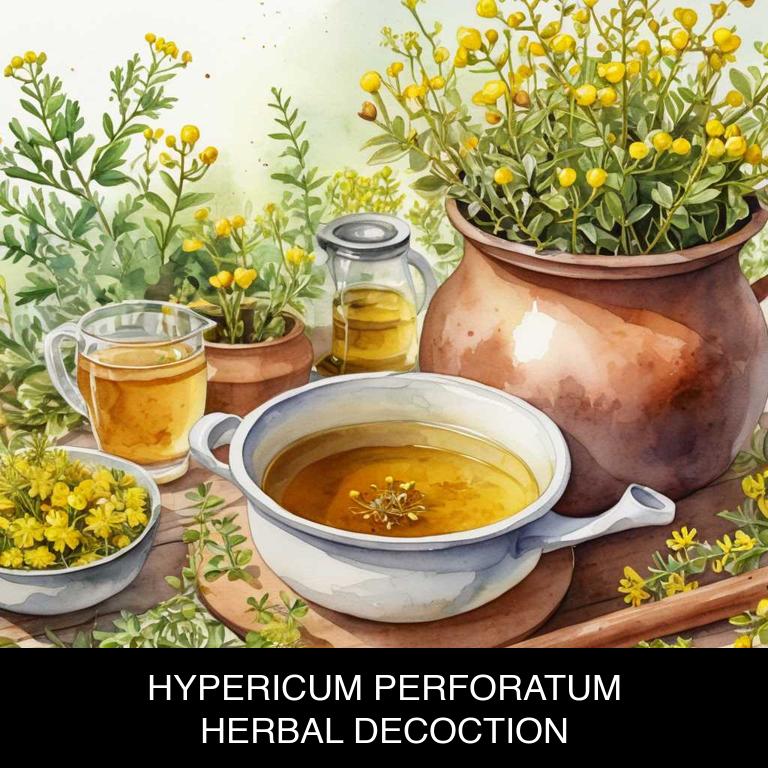
Medicinal Constituents
The list below shows the primary medicinal constituents in Hypericum perforatum decoctions that help with gum swelling.
- Quercetin: Quercetin, a flavonoid phenolic compound, helps reduce inflammation and swelling in gum tissues by inhibiting the production of pro-inflammatory enzymes.
- Hyperforin: Hyperforin, a phenolic compound, exhibits anti-inflammatory and antimicrobial properties, which help alleviate gum swelling by reducing bacterial growth and inflammation.
- Naphthodianthrones: These compounds have potent antioxidant and anti-inflammatory properties, which help mitigate gum swelling by neutralizing free radicals and reducing oxidative stress.
Parts Used
The list below shows the primary parts of st john's wort used to make decoctions for gum swelling.
- Leaves: Leaves are used due to their high flavonoid content, particularly hyperoside and quercetin, which exhibit anti-inflammatory properties that help reduce gum swelling.
- Roots: Roots are used due to their high concentration of flavonoids, including hyperforin and adhyperforin, which have anti-inflammatory and antiseptic properties that aid in gum swelling reduction.
- Stems: Stems are used due to their high flavonoid content, including rutin, which has anti-inflammatory properties that help alleviate gum swelling and promote healing.
Quick Recipe
The following recipe gives a procedure to make a basic st john's wort for gum swelling.
- Harvest the aerial parts of hypericum perforatum when flowers are in full bloom and dry them thoroughly.
- Measure out 10-20 grams of dried hypericum perforatum and place it in a saucepan.
- Add 500 milliliters of water to the saucepan and bring the mixture to a boil.
- Reduce the heat and simmer the mixture for 5-10 minutes or until the liquid has reduced slightly.
- Strain the decoction through a cheesecloth or a fine-mesh sieve and discard the solids.
7. Myrrhis odorata
Sweet cicely decoctions helps with gum swelling because they contain a unique combination of flavonoids, phenolic acids, and volatile oils that have anti-inflammatory properties.
These compounds work to reduce inflammation and swelling in the gums by inhibiting the production of pro-inflammatory enzymes and mediators. Additionally, the decoction's antioxidant activity helps protect the gums from oxidative damage caused by chronic gum disease, promoting a healthy and calm gum environment.
This natural remedy can provide effective relief from gum swelling and discomfort.
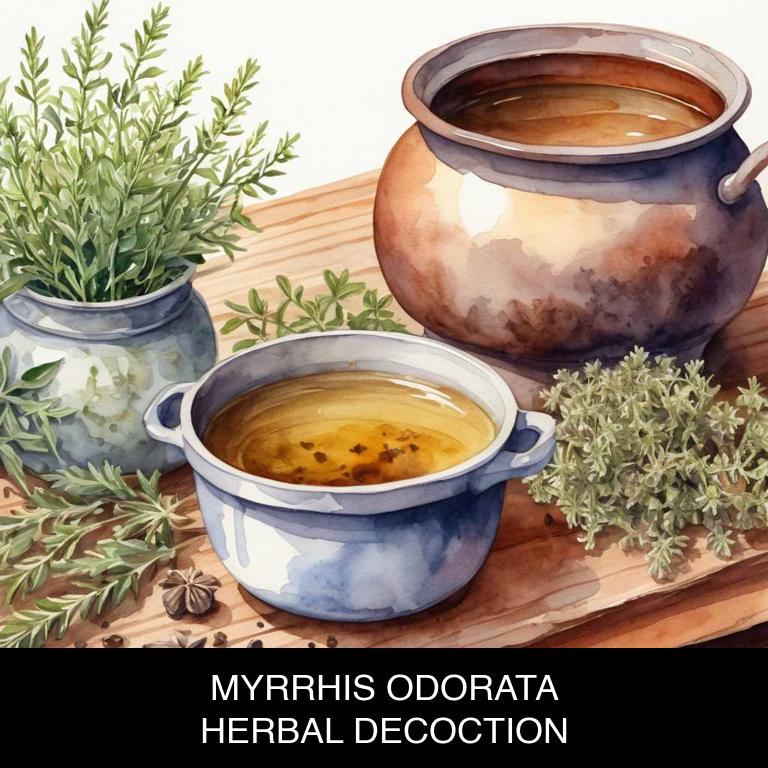
Medicinal Constituents
The list below shows the primary medicinal constituents in Myrrhis odorata decoctions that help with gum swelling.
- Phenolic acids: Help reduce inflammation and swelling by inhibiting the production of pro-inflammatory enzymes and cytokines.
- Flavonoids: Display anti-inflammatory and antioxidant properties, which can help alleviate gum swelling and promote healing by reducing oxidative stress and inflammation.
- Terpenes: Exert anti-inflammatory effects, reducing swelling and pain in the gums by inhibiting the production of pro-inflammatory mediators and promoting the production of anti-inflammatory compounds.
Parts Used
The list below shows the primary parts of sweet cicely used to make decoctions for gum swelling.
- Roots: They are rich in volatile oils and other compounds that help reduce inflammation and alleviate gum swelling.
- Leaves: Leaves of Myrrhis odorata contain compounds with anti-inflammatory properties that help soothe swollen gums.
- Barks: Barks of the plant have been traditionally used to create decoctions that help reduce gum inflammation and swelling.
Quick Recipe
The following recipe gives a procedure to make a basic sweet cicely for gum swelling.
- Harvest 1-2 cups of fresh myrrhis odorata leaves and roots from the wild or your garden.
- Dry the harvested plant material in a warm oven at 150°f for 1-2 hours.
- Combine 1 teaspoon of dried myrrhis odorata with 1 cup of boiling water in a saucepan.
- Reduce heat to a simmer and let the decoction steep for 10-15 minutes.
- Strain the decoction and discard the solids before serving or storing in the refrigerator.
8. Symphytum officinale
Comfrey decoctions helps with gum swelling because of its unique composition, rich in allantoin, a potent anti-inflammatory agent.
When consumed as a herbal tea or added to mouthwash, comfrey's soothing properties help reduce inflammation and alleviate discomfort associated with swollen gums. Additionally, comfrey's antioxidant and mucilaginous properties aid in healing and protecting the gum tissue, promoting a healthy environment for optimal oral health.
By reducing swelling and discomfort, comfrey decoctions provide relief for individuals experiencing gum issues related to gum disease or other inflammatory conditions.
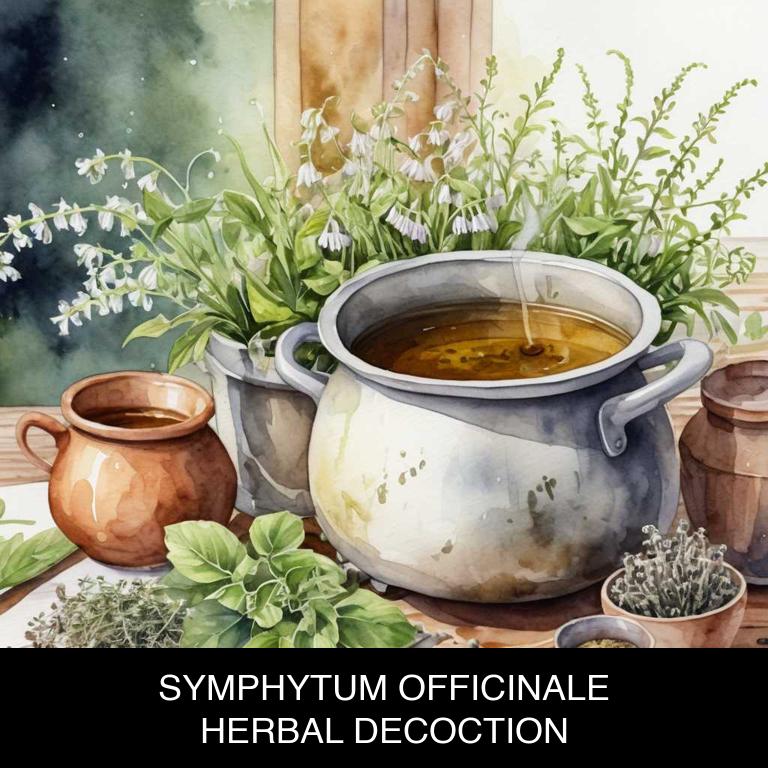
Medicinal Constituents
The list below shows the primary medicinal constituents in Symphytum officinale decoctions that help with gum swelling.
- Aesculin: Aesculin has anti-inflammatory properties, which help to reduce swelling and inflammation in the gums by inhibiting the production of pro-inflammatory enzymes.
- Symphytine: Symphytine, a triterpene saponin, exhibits anti-inflammatory and anti-swelling effects by inhibiting the production of pro-inflammatory cytokines and enzymes that contribute to gum swelling.
- Allantoin: Allantoin, a glycosidic compound, has anti-inflammatory and soothing properties, which help to reduce swelling, pain, and inflammation in the gums by promoting the healing of tissues and reducing the production of pro-inflammatory mediators.
Parts Used
The list below shows the primary parts of comfrey used to make decoctions for gum swelling.
- Leaves: They are rich in mucilages, which help to soothe and reduce inflammation in the gums.
- Roots: They contain compounds that have anti-inflammatory and antiseptic properties, which aid in treating gum swelling and infections.
- Stems: They also contain mucilages, which help to protect and calm the gums, reducing swelling and inflammation.
Quick Recipe
The following recipe gives a procedure to make a basic comfrey for gum swelling.
- Harvest fresh leaves of symphytum officinale when they are in their active growth stage.
- Rinse the harvested leaves thoroughly with clean water to remove any dirt particles.
- Combine 1 gram of dried symphytum officinale leaves with 250 milliliters of boiling water in a saucepan.
- Steep the mixture for 10 to 15 minutes to allow the herbal properties to infuse.
- Strain the decoction through a cheesecloth or a fine-mesh sieve into a clean container.
9. Achillea millefolium
Yarrow decoctions helps with gum swelling because of its natural anti-inflammatory properties.
The flavonoids and phenolic acids present in yarrow leaves and flowers inhibit the production of prostaglandins, which are responsible for swelling and pain. This reduction in inflammation helps to alleviate gum puffiness and discomfort, promoting a healthier and more comfortable oral environment.
Regular consumption of yarrow decoctions may also help to reduce plaque and prevent further gum damage, leading to improved overall oral health.
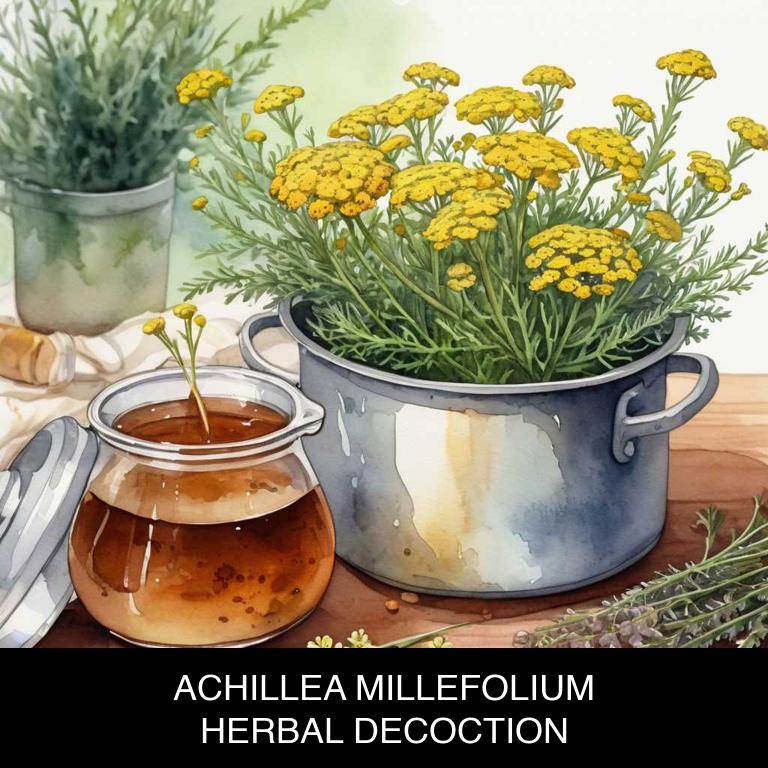
Medicinal Constituents
The list below shows the primary medicinal constituents in Achillea millefolium decoctions that help with gum swelling.
- Apigenin: This flavonoid acts as an anti-inflammatory agent, reducing swelling and pain associated with gum inflammation.
- Ligustilide: A sesquiterpene lactone, ligustilide exhibits anti-inflammatory properties, which help in alleviating gum swelling and related discomfort.
- Achilleine: A sesquiterpene, achilleine has been shown to possess anti-inflammatory and antioxidant activities, which contribute to its potential in reducing gum inflammation.
Parts Used
The list below shows the primary parts of yarrow used to make decoctions for gum swelling.
- Leaves: They are used to make decoctions for gum swelling due to their anti-inflammatory properties, which help reduce swelling and pain.
- Roots: They are used to make decoctions for gum swelling due to their anti-inflammatory and antiseptic properties, which help to soothe and protect the affected area.
- Flowers: They are used to make decoctions for gum swelling due to their anti-inflammatory and antimicrobial properties, which help to reduce swelling and prevent infection.
Quick Recipe
The following recipe gives a procedure to make a basic yarrow for gum swelling.
- Gather dried achillea millefolium flowers and leaves from a trusted source or grow your own.
- Measure out 2 teaspoons of dried achillea millefolium flowers and leaves for every 8 ounces of water.
- Combine the measured achillea millefolium flowers and leaves with 8 ounces of boiling water in a heat-resistant cup.
- Allow the mixture to steep for 5 to 10 minutes or until the desired strength is achieved.
- Strain the decoction through a fine-mesh sieve or cheesecloth into a cup to remove solids.
10. Matricaria chamomilla
Chamomile decoctions helps with gum swelling because of its anti-inflammatory properties, which can effectively reduce redness and puffiness in the affected area.
The antioxidants present in chamomile also help to soothe irritated gums and promote healing. When used as a mouthwash or gargle, chamomile decoctions can penetrate deep into the gum tissue, reducing inflammation and swelling.
This natural remedy can provide fast relief from gum discomfort and promote overall oral health.
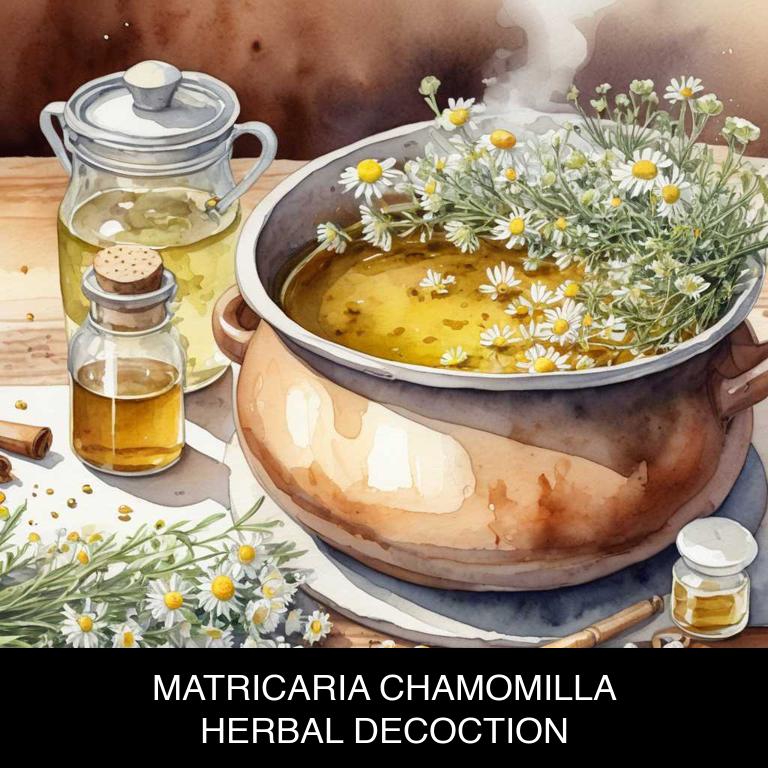
Medicinal Constituents
The list below shows the primary medicinal constituents in Matricaria chamomilla decoctions that help with gum swelling.
- Apigenin: As a flavonoid with anti-inflammatory properties, apigenin helps to reduce swelling and inflammation in gum tissues.
- Alpha-bisabolol: This sesquiterpene alcohol exhibits anti-inflammatory and antibacterial properties, which help to alleviate gum swelling and infection.
- Luteolin: As a flavonoid with potent anti-inflammatory and antioxidant properties, luteolin helps to reduce inflammation and protect gum tissues from oxidative damage.
Parts Used
The list below shows the primary parts of chamomile used to make decoctions for gum swelling.
- Flowers: They are used due to their anti-inflammatory and soothing properties, which help reduce swelling and pain in the gums.
- Leaves: They are used for their potential anti-inflammatory and antimicrobial properties, which aid in reducing gum inflammation and infection.
- Seeds: They are used due to their potential anti-inflammatory and antimicrobial properties, which help reduce gum swelling and prevent infection.
Quick Recipe
The following recipe gives a procedure to make a basic chamomile for gum swelling.
- Harvest 20-30 dried flowers of matricaria chamomilla and store them in a cool dry place.
- Measure 1-2 teaspoons of the dried flowers for every 8 ounces of water.
- Combine the measured flowers with 8 ounces of boiling water in a heat-resistant cup.
- Steep the mixture for 5-7 minutes or until the flowers have lost their flavor and color.
- Strain the decoction and discard the flowers before serving it warm or at room temperature.
What is the best combination of herbal decoctions to use for gum swelling?
The best combination of herbal decoctions that help with gum swelling is a blend of Calendula, Echinacea, and Sage.
Calendula soothes and reduces inflammation, while Echinacea helps to boost the immune system and fight off infection. Sage, rich in antioxidants, helps to reduce inflammation and promote healing of the gums. Combine equal parts of each decoction and drink 2-3 times a day to help alleviate gum swelling and promote overall oral health.
This combination may also help prevent future gum issues.
What ailments similar to gum swelling are treated with herbal decoctions?
Ailments similar to gum swelling that are treated with herbal decoctions are various inflammatory conditions, including arthritis, rheumatism, and joint pain.
Herbal decoctions like turmeric, ginger, and boswellia have anti-inflammatory properties that help reduce swelling and ease discomfort in these conditions.
Additionally, decoctions made from herbs like calendula, chamomile, and peppermint can soothe oral mucositis and other mouth sores, providing relief similar to gum swelling.